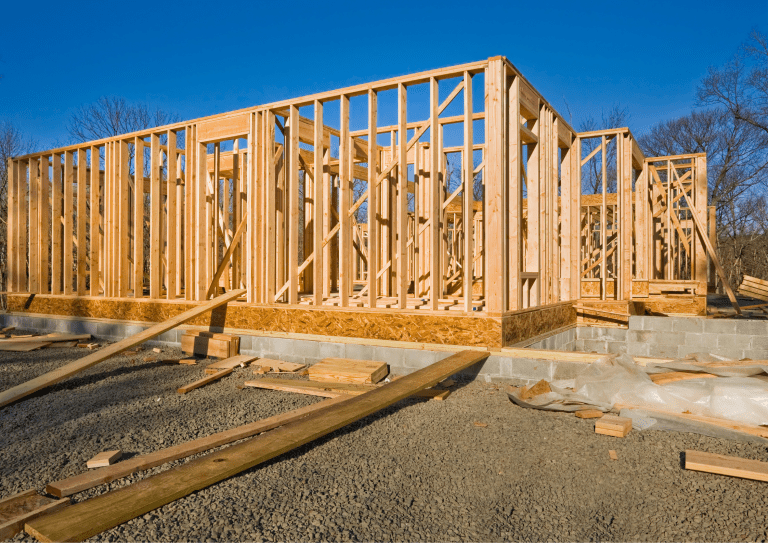Timber Frame Construction Mortgage

"I'm a Specialist Mortgage Advisor who can help your property dreams come true."
Ross McMillan
Blue Fish Mortgage Solutions
As a former estate agent of almost 15 years, I now use my vast experience, insider knowledge and access to dozens of lenders to help people like you:
- Secure the right mortgage for your circumstances.
- Successfully master the Scottish property buying process from start to finish.
- Achieve your property ambitions - however big or small
Get in touch for a no-obligation chat about how I might be able to help you.
YOUR HOME MAY BE REPOSSESSED IF YOU DO NOT KEEP UP REPAYMENTS ON YOUR MORTGAGE.
Some Buy to Let mortgages are not regulated by the Financial Conduct Authority.
Home » Non-Standard Construction Mortgage » Timber Frame Construction Mortgage
Table of Contents
Looking to purchase a home using a timber frame construction mortgage in the UK? If so, you will need to understand the unique features and requirements of these types of mortgages, as well as how to apply for one. In this article, we will explore the basics of timber frame construction mortgages, including eligibility and some tips for getting approved and finding the right lender.
Compared to a traditional mortgage, getting a mortgage for this type of property construction can sometimes present unique challenges and considerations.
If you are interested in buying a timber frame house, it is important to do your research ahead of time so that you understand the key features and benefits of this type of construction.

What is a timber frame construction mortgage?
Timber frame construction is a building technique that involves using a framework of timber posts and beams to support the structure of a building. The spaces between the timbers are then typically filled with insulation and cladding to create the walls, roof, and floors. Timber frame construction can deliver a low carbon footprint, as it uses renewable and sustainable materials. It is also known for its fast construction times and flexibility in design.
Depending on a number of varyiing factors, a timber frame construction property may be considered to be non-standard construction by some mortgage lenders.
Is it possible to get a mortgage for a timber frame property in the UK?
The short answer is yes, you can get a mortgage on a timber-framed house in the UK. However, there are some things you need to be aware of before you apply for a mortgage.
Firstly, some mortgage lenders may be more hesitant to lend on timber-framed properties due to concerns around their durability and long-term maintenance. Timber-framed houses may require more maintenance than traditional brick and mortar homes, and some lenders may consider them to be a higher risk.
However, this doesn’t mean that you won’t be able to find a mortgage lender who will lend on a timber-framed house. There are plenty of lenders out there who are happy to lend on timber-framed properties, as long as certain criteria are met.
One of the most important criteria is that the timber-framed house must meet current building regulations. This means that it must be built to the same standards as traditional brick and mortar homes, with the same levels of insulation and structural integrity. If the timber-framed house was built before current regulations came into force, it may be more difficult to get a mortgage on it.
Another important consideration is the construction method of the timber-framed house. There are two main types of timber-framed construction – traditional and modern. Traditional timber-framed houses use oak or other hardwoods, and are often listed buildings. Modern timber-framed houses, on the other hand, use softwoods and are more common. Some mortgage lenders may be more hesitant to lend on traditional timber-framed houses due to their unique construction method and potential for higher maintenance costs.
What are some reasons that could lead a lender to decline a mortgage application for a timber-framed house?
Beyond the general criteria for any mortgage, lenders may sometimes decline a mortgage application on timber-framed houses for a variety of reasons. Here are some of the most common reasons why a lender may refuse a mortgage on a timber-framed house:
Lack of knowledge and experience: Some lenders may not have experience with timber-framed houses, and therefore may not be comfortable with the construction method. This lack of knowledge can lead to hesitation in lending or outright refusal of a mortgage.
Valuation concerns: Timber-framed houses may be more difficult to value than traditional brick and block properties. This can lead to concerns about the property’s resale value and the lender’s ability to recover their investment in the event of default.
Structural concerns: Some lenders may be concerned about the structural integrity of timber-framed houses. However, modern timber-framed houses are built to strict building codes and regulations, and are generally very safe and sturdy.
Fire risk: There may be concerns about the fire risk associated with timber-framed houses, as wood is a combustible material. However, modern timber-framed houses are built with fire-resistant materials and are subject to strict fire safety regulations.
Perception of higher risk: Lenders may perceive timber-framed houses to be a higher risk due to the perception of the unknown or lack of experience with this type of construction method. This perception can lead to higher deposit requirements, additional structural reports requested or refusal of a mortgage altogether.
Speak to an expert!
Contact me, Ross McMillan, the owner of Blue Fish Mortgage Solutions today for expert advice and guidance on your unique mortgage and property needs. I will work with you one-on-one to help you find the right solution for your specific needs. With my expertise and industry connections, you can rest assured that you are in good hands when it comes to securing the financing you need for your property.

What are the most common types of residential timber frame construction properties in the UK and what are the likely mortgage implications are there for each?
There are several types of residential timber frame construction properties in the UK, and each has different mortgage implications. In each case it’s important to have a detailed valuation and survey of the property that will ensure and determine whether any specific lender is comfortable with the construction method. Here are the most common:
Open Panel Systems: This is the most common type of timber frame construction in the UK, and many lenders are familiar with it. Mortgage lenders may sometimes require a higher deposit for an open panel system property than for a traditional brick and block property.
Closed Panel Systems: Closed panel systems offer superior energy efficiency and can be faster to install on-site. However, they are less common than open panel systems, and some lenders may be less familiar with them.
Structural Insulated Panels (SIPs): SIPs are a newer type of timber frame construction, and some lenders may also be less familiar and therefore uncomfortable with them. A more detailed valuation and survey may be necessary to ensure that the lender is comfortable with this construction method.
Timber Frame and Masonry Hybrid: This type of construction combines the benefits of timber frame construction with traditional masonry walls. The timber frame provides the structural support, while the masonry walls provide thermal mass and durability. Mortgage lenders are generally comfortable with this type of construction, as it combines the benefits of both timber and traditional masonry construction.
What are the eligibility requirements for getting a timber frame construction mortgage?
When it comes to timber frame construction, there are a few things you’ll need to take into account when applying for a mortgage.
For starters, the specific type of timber-frame construction will play a role in the eligibility requirements as will the age of the property, the era it was built within and details of any other materials used in the construction will also be taken into consideration.
The valuer/surveyor comments around the specific type of construction and associated suitability for mortgage lending purposes within the survey will be the critical factor in determining the viability of obtaining a mortgage for any non-standard construction style of property, including timber frame.
Furthermore, as with all types of mortgage lending, your credit history, employment details and personal circumstances will be checked in order to assess and underwrite responsibly any application made.
How do you go about applying for a timber frame construction mortgage, and what documentation will you likely need to provide?
If you’re considering a timber frame construction mortgage in the UK, the first step is to speak to a mortgage advisor. They’ll be able to help you understand the different types of mortgages available and which one would best suit your needs. They’ll also be able to tell you what specific documentation you’ll need to provide in order to apply for a mortgage. In most cases, you’ll need to provide proof of income, employment history, and creditworthiness. You will also need to provide evidence of your deposit which in some instances if the property is considered of non-standard construction by some mortgage lenders this may need to be more than for traditional built properties.
Conclusion
If you’re looking to buy a property that is built with timber frame construction, there are lenders available providing finance for this type of property. However, it’s important to keep in mind that some timber frame construction properties just like BISF- Steel-Frame or Wimpey No Fines are considered non-standard, which means that you may need to provide a larger deposit and your credit history, employment details, and personal circumstances will be taken into account when determining your eligibility for a timber frame mortgage so make sure these are all in good order at all times. With the help of a qualified mortgage advisor such as me, however, you’ll be able to find the right deal for your needs
Looking to buy or refinance a property with timber frame construction? If so, get in touch with Blue Fish Mortgage Solutions today. As an expert mortgage advisor, I can help you find the right deal for your needs and guide you through the application process.

What are the key stages of the property buying process in Scotland:
- Speak to mortgage advisor to establish and get advice on what a realistic budget for your individual circumstance might be.
- Mortgage advisor may then progress to obtain an agreement/decision in principle to give you some confidence – not a guarantee – that you could obtain a mortgage. (aka an AIP/DIP)
- Start viewings and then identify property you would like to offer on.
- Instruct solicitor to make offer. (once you’ve done sums and consulted with your mortgage advisor to double check/firm up on figures etc)
- Once offer accepted, we then look to progress the agreement in principle (AIP) to a full mortgage application.
- Legal conveyancing between both solicitors commences.
- Once mortgage offer received, solicitor could be in a position to confirm the legal bargain (aka conclude missives) which would include a definitive date of entry/settlement date.
- For the date of entry, the monies required from you (i.e. deposit) need to be in your solicitors bank account and cleared.
- Solicitor draws down/receives funds from mortgage lender to complete the purchase.
- On the date of entry get keys for your new house.
Hopefully the above information has been useful but if you have any other questions or are ready to start your own property journey now, please fill in the enquiry form and we will get in touch!
This article is intended to be a generic overview and each individual situation will need to be considered carefully, with the final decision being down to the lender.

Let's Make Things Happen.
Take The First Steps Now And Request Your Initial Discovery Call.
Request your initial discovery call by filling out your details here and I will personally be in touch within 48 hours by text, WhatsApp or email to arrange your no obligation chat!



